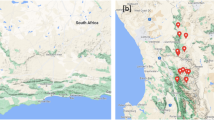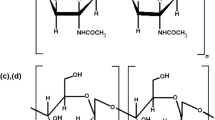Abstract
The traditional medicinal properties of Carpobrotus edulis are well recognized, particularly in Tunisia where it is used for wound healing. Thus, in this study, biochemical and molecular properties of its leaves’ bioactive aqueous-acetone extract were investigated. The total phenolic content (TPC) of the extract was estimated to be 184 ± 5 mg/100 g of fresh matter (FM). The qualitative and quantitative polyphenolic profile was determined by ultra performance liquid chromatography with diode array detection (UPLC-DAD) and showed that chlorogenic acid was the major compound (43.7%). The extract exhibits potent antioxidant capacities with IC50 = 56.19 and 58.91 μg/ml, as accessed via the anionic DPPH and cationic ABTS radical scavenging assays, respectively. The extract has high antibacterial properties, especially against the Gram+ Staphylococcus aureus and Bacillus cereus strains. To investigate the extract effect on regeneration, the flatworm Dugesia sicula Lepori, 1948, was used as a model. The macroscopic analysis of planarian cultures in ordinary medium containing phenolic extract at non-toxic concentrations illustrated that the extract caused morphological changes. Additionally, the molecular study through the fluorescence-activated cell sorting (FACS) technique showed that C. edulis polyphenols can harm the stem cells’ development. These results emphasize the ecotoxicological impact of phenolic rejections in the environment on flatworms’ physiology.



Similar content being viewed by others
References
Foster, S., Hobbs, C., & Peterson, R. T. (2002). A field guide to western medicinal plants and herbs (p. 448). New York: Houghton Mifflin Co.
Taguri, T., Tanaka, T., & Kouno, I. (2006). Antibacterial spectrum of plant polyphenols and extracts depending upon hydroxyphenyl structure. Biological and Pharmaceutical Bulletin, 29, 2226–2235.
Puupponen-Pimiä, R., Nohynek, L., Hartman-Schmidlin, S., Kähkönen, M., Heinonen, M., & Mata-Riihinen, K. (2005). Berry phenolics selectively inhibit the growth of intestinal pathogens. Journal of Applied Microbiology, 98, 991–1000.
Novoa, A., & Gonzalez, L. (2014). Impact of Carpobrotus edulis (L.) N.E.Br. on the germination, establishment and survival of native plants: a clue for assessing its competitive strength. PlosONE, 9, 1–12.
Martins, A., Vasas, A., Schelz, Z., Viveiros, M., Molnar, J., Hohmann, J., & Amaral, L. (2010). Constituents of Carpobrotus edulis inhibit P-glycoprotein of MDR1-transfected mouse lymphoma cells. Anticancer Research, 30, 829–836.
Pirie, A. D., Davies, N. W., Ahuja, K. D., Adams, M. J., Shing, C. M., Narkowicz, C., Jacobson, G. A., & Geraghty, D. P. (2014). Hypolipidaemic effect of crude extract from Carpobrotus rossii (pigface) in healthy rats. Food and Chemical Toxicology, 66, 134–139.
Omoruyi, E. B., Bradley, G., & Afolayan, J. A. (2012). Antioxidant and phytochemical properties of Carpobrotus edulis (L.) bolus leaf used for the management of common infections in HIV/AIDS patients in Eastern Cape Province. BMC Complementary and Alternative Medicine, 12, 215. doi:10.1186/1472-6882-12-215.
Navneet, K. Y., Pooja, S., Ankur, O., & Singh, R. K. (2013). In silico approach to uncover the anti-cancerous activity of certain phyto-compounds. Gene Therapy & Molecular Biology, 15, 147–158.
Hayashi, T., Asami, M., Higuchi, S., Shibata, N., & Agata, K. (2006). Isolation of planarian X-ray-sensitive stem cells by fluorescence-activated cell sorting. Development Growth and Differentiation, 48, 371–380.
Moritz, S., Stöckle, F., Ortmeier, C., Schmitz, H., Rodríguez-Esteban, G., Key, G., & Gentile, L. (2012). Heterogeneity of planarian stem cells in the S/G2/M phase. The International Journal of Developmental Biology, 56, 117–125.
Charni, M., Harrath, A. H., Sluys, R., Tekaya, S., & Zghal, F. (2004). The freshwater planarian Dugesia sicula Lepori, 1948 (Platyhelminthes, Tricladida) in Tunisia: ecology, karyology, and morphology. Hydrobiologia, 517(1), 161–170.
Fattouch, S., Caboni, P., Coroneo, V., Tuberoso, C. I. G., Angioni, A., Dessi, S., Marzouki, N., & Cabras, P. (2007). Antimicrobial activity of Tunisian quince (Cydonia oblonga Miller) pulp and peel polyphenolic extracts. Journal of Agricultural and Food Chemistry, 55, 963–969.
Dhaouadi, K., Raboudi, F., Funez-Gomez, L., Pamies, D., Estevan, C., Hamdaoui, M., & Fattouch, S. (2013). Polyphenolic extract of barbary-fig (Opuntia ficus-indica) syrup: RP–HPLC–ESI–MS analysis and determination of antioxidant, antimicrobial and cancer-cells cytotoxic potentials. Food Analytical Methods, 6, 45–53.
Najjaa, H., Zerria, K., Fattouch, S., Ammar, E., & Neffati, M. (2011). Antioxidant and antimicrobial activities of Allium roseum. “lazoul”, a wild edible endemic species in North Africa. International Journal of Food Properties, 14, 371–380.
Chen, Z., Wu, J. B., Liao, X. J., Yang, W., & Song, K. (2010). Development and validation of an UPLC–DAD–MS method for the determination of leonurine in Chinese motherwort (Leonurus japonicus). Journal of Chromatographic Science, 48, 802–806.
Fratianni, F., Coppola, R., & Nazzaro, F. (2011). Phenolic composition and antimicrobial and antiquorum sensing activity of an ethanolic extract of peels from the apple cultivar Annurca. Journal of Medicinal Food, 14(9), 957–963.
Fratianni, F., Cardinale, F., Cozzolino, A., Granese, T., Albanese, D., Di Matteo, M., Zaccardelli, M., Coppola, R., & Nazzaro, F. (2014). Polyphenol composition and antioxidant activity of different grass pea (Lathyrus sativus), lentils (Lens culinaris), and chickpea (Cicer arietinum) ecotypes of the Campania region (southern Italy). Journal of Functional Foods, 7, 551–557.
Wilson, M. A., Shukitt-Hale, B., Kalt, W., Ingram, D. K., Joseph, J. A., & Wolkow, C. A. (2006). Blueberry polyphenols increase lifespan and thermotolerance in Caenorhabditis elegans. Aging Cell, 5, 59–68.
Salvetti, A., Rossi, L., Bonuccelli, L., Lena, A., Pugliesi, C., Rainaldi, G., Evangelista, M., & Gremigni, V. (2009). Adult stem cell plasticity: neoblast repopulation in non-lethally irradiated planarians. Developmental Biology, 328, 305–314.
Fattouch, S., Caboni, P., Coroneo, V., Tuberoso, C. I. G., Angioni, A., Dessi, S., Marzouki, N., & Cabras, P. (2008). Comparative analysis of polyphenolic profiles and antioxidant and antimicrobial activities of Tunisian pome fruit pulp and peel aqueous acetone extracts. Journal of Agricultural and Food Chemistry., 56, 1084–1090.
Huang, D. J., Lin, C. D., Chen, H. J., & Lin, Y. H. (2004). Antioxidant and antiproliferative activities of sweet potato (Ipomoea batatas) constituents. Botanical Bulletin- Academia Sinica, 45, 179–186.
Johnston, K. L., Clifford, M. N., & Morgan, L. M. (2003). Coffee acutely modifies gastrointestinal hormone secretion and glucose tolerance in humans: glycemic effects of chlorogenic acid and caffeine. American Journal of Clinical Nutrition, 78, 728–733.
Suzuki, A., Yamamoto, N., Jokura, H., Yamamoto, M., Fujii, A., Tokimitsu, I., & Saito, I. (2006). Chlorogenic acid attenuates hypertension and improves endothelial function in spontaneously hypertensive rats. Journal of Hypertension, 24, 1065–1073.
Koech, K. R., Wachira, F. N., Ngure, R. M., Wanyoko, J. K., Bii, C. C., Karori, S. M., & Keriol, L. C. (2013). Antimicrobial, synergistic and antioxidant activities of tea polyphenols. Microbial pathogens and strategies for combating them: science, technology and education, 6, 971–981.
Prakash, A., Rigelhof, F., & Miller, E. (2001). Antioxidant activity. Medallion Laboratories Analytical Progress, 19, 1–4.
Bouftira, I., Abdelly, C., & Sfar, S. (2012). Antioxidant and antibacterial properties of Mesembryanthemum crystallinum and Carpobrotus edulis extracts. Advances in Chemical Engineering and Science, 2, 359–365.
Dhaouadi, K., Raboudi, F., Estevan, C., Barrajo, E., Vilanova, E., Hamdaoui, M., & Fattouch, S. (2011). Cell viability effects and antioxidant and antimicrobial activities of Tunisian date syrup (rub el tamer) polyphenolic extracts. Journal of Agricultural and Food Chemistry, 59, 402–406.
Hattori, M., Kusumoto, I. T., Namba, T., Ishigami, T., & Hara, Y. (1990). Effect of tea polyphenols on glucan synthesis by glucosyltransferase from Streptococcus mutans. Chemical & Pharmaceutical Bulletin, 38, 717–720.
Zaixiang, L., Hongxin, W., Song, Z., Chaoyang, M., & Zhouping, W. (2011). Antibacterial activity and mechanism of action of chlorogenic acid. Journal of Food Science, 76, M398–M403.
Fernando, C., Cristina, A. L., Sara, T., Francisco, J. T., & María, I. Q. (2013). Benefits of polyphenols on gut microbiota and implications in human health. Journal of Nutritional Biochemistry, 24, 1415–1422.
Sirk, T. W., Friedman, M., & Brown, E. F. (2011). Molecular binding of black tea Theaflavins to biological membranes: relationship to bioactivities. Journal of Agricultural and Food Chemistry, 59, 3780–7787.
Daglia, M. (2012). Polyphenols as antimicrobial agents. Current Opinion in Biotechnology, 23, 174–181.
Sakai, F., Agata, K., Orii, H., & Watanabe, K. (2000). Organization and regeneration ability of spontaneous supernumerary eyes in planarians—eye regeneration field and pathway selection by optic nerves. Zoological Science, 17, 375–381.
Sanchez Alvarado, A., Newmark, P. A., Robb, S. M., & Juste, R. (2002). The Schmidtea mediterranea database as a molecular resource for studying platyhelminthes, stem cells and regeneration. Development, 129, 5659–5665.
Handberg-Thorsager, M., Fernandez, E., & Salo, E. (2008). Stem cells and regeneration in planarians. Frontier Biosciences, 13, 6374–6394.
Wagner, D. E., Wang, I. E., & Reddien, P. W. (2011). Clonogenic neoblasts are pluripotent adult stem cells that underlie planarian regeneration. Science, 332, 811–816.
Hayashi, T., Shibata, N., Okumura, R., Kudome, T., Nishimura, O., Tarui, H., & Agata, K. (2010). Single-cell gene profiling of planarian stem cells using fluorescent activated cell sorting and its “index sorting” function for stem cell research. Development Growth and Differentiation, 52, 131–144.
Aloui, S., Raboudi, F., Ghazouani, T., Salghi, R., Hamdaoui, M. H., & Fattouch, S. (2014). Use of molecular and in silico bioinformatic tools to investigate pesticide binding to insect (Lepidoptera) Phenoloxidases (PO): insights to toxicological aspects. Journal of Environmental Science and Health, Part B: Pesticides, Food Contaminants and Agricultural Waste, 49, 654–660.
Raboudi, F., Fattouch, S., Makni, H., & Makni, M. (2012). Biochemical and molecular analysis of the Pirimicarb effect on Acetylcholinesterase resistance in Tunisian populations of potato aphid Macrosiphum euphorbiae (Hemiptera: Aphididae). Pesticide Biochemistry and Physiology, 104, 261–266.
Acknowledgments
This work has been supported, in part, by a fellowship grant to Emna MEDDEB, by recurrent funding from the Ministry of Higher Education and Scientific Research. We thank Henning Schmitz (Max Planck Institute for Molecular Biomedicine, Münster, Germany) for help with the FACS technique.
Author information
Authors and Affiliations
Corresponding author
Electronic supplementary material
Supplementary Table 1
Antibacterial potentials of the Carpobrotus edulis extracts and Ampicillin as positive control. (DOCX 13 kb)
Supplementary Figure 1
Graphical presentation of the One-way ANOVA of the the Carpobrotus edulis antibacterial potential. (DOCX 45 kb)
Supplementary Figure 2
Planarian in the 7th day of regeneration. A. untreated planarian. B. Planarian treated with 75% MIC. C. Planarian treated with 100% MIC. (DOCX 663 kb)
Supplementary Figure 3
Graphical presentation of the One-way ANOVA of the morphometric characters. (*) Significant results. (DOCX 41 kb)
Supplementary Figure 4
Planarian treated with 15 mg/ml of Carpobrotus edulis polyphenol extract. Eyes are shown by yellow arrows ends. (DOCX 1095 kb)
Supplementary Figure 5
Count different cell populations of irradiated (a), untreated (b) and treated animals with Carpobrotus edulis polyphenols (c). (DOCX 255 kb)
Rights and permissions
About this article
Cite this article
Meddeb, E., Charni, M., Ghazouani, T. et al. Biochemical and Molecular Study of Carpobrotus edulis Bioactive Properties and Their Effects on Dugesia sicula (Turbellaria, Tricladida) Regeneration. Appl Biochem Biotechnol 182, 1131–1143 (2017). https://doi.org/10.1007/s12010-016-2387-y
Received:
Accepted:
Published:
Issue Date:
DOI: https://doi.org/10.1007/s12010-016-2387-y




